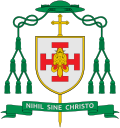This article needs additional citations for verification .(September 2014) |

St. Peter and St. Paul Roman Catholic Church is a parish of the Roman Catholic Church in Newport, Shropshire, England. The parish covers Newport and the surrounding villages as far as Hinstock.
Contents
Salters Hall, in Salters Lane, Newport, is attached to the church. It was designed by Augustus Pugin and built in 1852.



